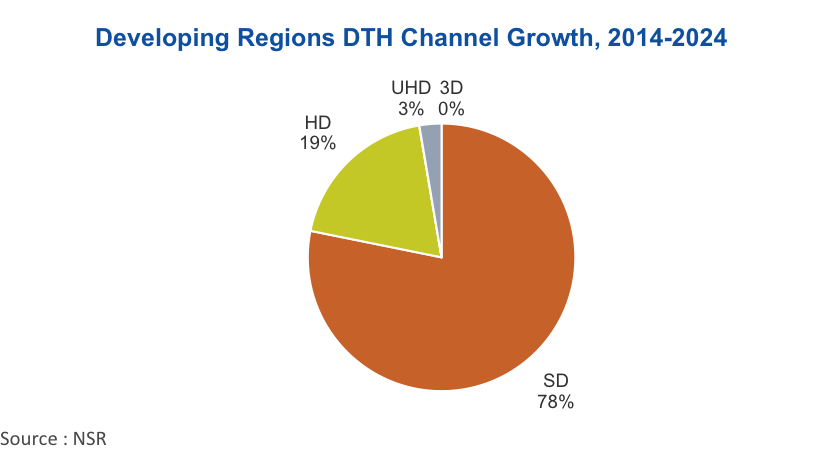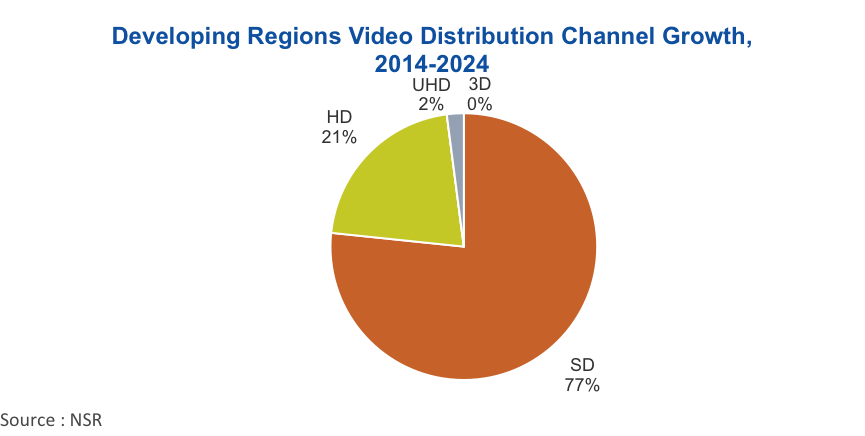SD Still King in High Growth Regions
May 27th, 2015 by
Alan Crisp, NSR
NSR previously noted that the DTH market is undergoing a great
divergence. Whilst in developed regions, UltraHD is poised be the
next big revenue driver, the fastest-growing developing markets tell
a very different story.
Sharp has now released 4K TV sets for under $600, and with all
the continued talk about UltraHD, one would be excused from thinking
that the transition to HD broadcasting is nearing its end, making
way for the future of UltraHD broadcasting globally. However, NSR’s
most recent study, Linear TV via Satellite: DTH, OTT and IPTV, 8th
Edition, finds that despite the hype, Standard Definition
(SD) still has strong growth potential in developing regions.

When looking at developing regions (defined here as Central and
South America, Middle East/North Africa, Sub-Saharan Africa, South
Asia, and Southeast Asia), the number of DTH channels available to
consumers is expected to show strong increases to 2024, from
approximately 7,300 to just over 12,700 DTH channels. Of the
nearly 5,400 channels to be added in these regions to 2024, over 78%
will be Standard Definition, with similar trends for Video
Distribution.

In more developed regions such as North America, growth
is primarily derived through increasing ARPUs. This results
in a transition from basic to premium channel packages, and a
reduced SD TPE capacity of -3.1% CAGR from 2014 to 2024 for DTH and
flat growth for video distribution. However, in developing
regions, growth is primarily driven by increasing subscriber numbers,
resulting from increased economic growth and households purchasing
their first TV sets.
Meanwhile the UltraHD market in developing regions has
accelerated with Indian DTH platforms Videocon d2h and Tata
Sky launching their first UltraHD channels. The set-top boxes for
this service will cost around US$100 for subscribers, which, it
should be noted, is several years of a basic subscriber’s ARPU.
Other platforms, such as Kino Polska TV in Poland, have announced
their intention to deliver UltraHD channels to consumers. Although
these new channels will introduce new revenue streams for both DTH
platforms and satellite operators alike, it will still remain
dwarfed by the giant of SD content.
Whilst the SD format uses significantly less bandwidth to
broadcast than HD channels, a sizable over
40% of satellite capacity growth in developing regions is attributed
to the growth in SD channels, showing the critical
importance of the SD DTH market, which should not be overlooked.
Bottom Line
Developing regions have the highest growth rates worldwide for
linear TV platforms, and in these high growth regions, the greatest
demand for TPEs is still coming from growth in the number of SD
channels available, despite the current hype for UltraHD. While the
upper to upper-middle class in these developing regions will keep
demanding more HD and UltraHD content, for the majority of the
population, there is far greater value in having a greater selection
of content available. This is number one driver of growth in the
developing regions, and satellite capacity will follow this trend
moving forward.